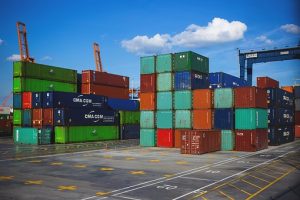Network And Fleet Improvements
Improvements to a network and fleet can take more time than operational or commercial moves, and they require strategic timing.
Two particular moves might boost earnings from 6 to 8 percent.

Own? Lease? The decision between the two is a question that has been central to strategy in container shipping for a long time. Analytics suggest, however, that the industry is overly reliant on leasing. There are unfortunately quite a few cash-strapped liners with significant debt, and leasing might be their only option. Still, other lines need to consider taking advantage of ownership for more and more of their own fleets. It is true that leasing offers a bit more flexibility in terms of changing vessel deployments, although that breathing room often comes at a steep price.
Shipping lanes might also be known as ‘trades’, and whatever you call them, they offer a unique test. Shipping carriers have to choose whether or not they want to deliver direct versus transship through an interim hub. This choice boils down to a handful of factors, like distance and the size of the ship. The trade-offs of yesteryear have certainly changed, given how today’s vessels are larger and fuel has gotten more expensive. However, shipping lines haven’t always kept up with things by making the needed changes across their networks.
Having said that, a few leading lines have been building fresh network tools in an attempt to work through these challenges.
Making Things Happen
As various lines adopt the complicated agenda previously outlined, they should also make organizational changes that put them in a good position for success.
There are five tactics in particular that can help most container-shipping lines reach their full potential.

1) Build Teams That Can Cross-Function:
Teams which can bring crucial functions together are able to make better decisions regarding the trade-offs that carriers face. For instance, one global carrier recently put an exception-management team into place that had both commercial and operations representatives. The mission of this team was to decide the murky questions that arise often in terms of vessel operations. Should a particular vessel speed up to reach Hong Kong where it could take on some transshipment cargo, or is it better to skip that port and keep sailing at a slower speed? An exception-management team can take both operational and commercial impacts into consideration so that it makes a good choice for the whole company.
2) Challenge The Status Quo:
Businesses are wise to sometimes shake up the status quo by embracing new perspectives, even if they’re controversial. One way to challenge pre-existing practices is by bringing in external experts. Companies have to innovate, so using a systemic approach to both finding and then testing out new ideas is something that can help out. Innovation is something that can happen across the entire enterprise, no matter the business or operational models or products or services. It can certainly happen when key operational processes get digitized. It’s not a stretch to think that inside the next three years, fresh technology start-ups might wind up creating a database point of view on cargo flows that is so superior that container lines get threatened by it. In fact, a number of new IT-enabled businesses have already made impressive inroads into the markets of logistics and freight-forwarding, whereas others aim to automate their processes for booking and invoicing ocean-freight. Anticipating this, many of the leading carriers are now investing in software and devices that track containers in live time. Even carriers that don’t do any of this need to at least pay attention to what’s going on.
3) Create A Culture Of Performance:
Programs which can transform business practices might start out strong, but they typically wind up fading over the following months or even years. In order to sustain improvements, shipping lines need to build a robust and routine performance-management system. Weekly dialogues always help improve transparency and can help the senior management make better decisions.
4) Redesign The Incentives:
Employees generally need both recognition and monetary incentives if they’re going to be an energetic part of any journey through transformation. Global shipping establishments need to rethink how they do their incentive program by coming up with a new design and then rolling it out. Programs might include brand-new key performance indicators, ceremonies, recognition awards, and bonus pools. It’s crucial to achieve a good balance of non-monetary and monetary incentives in order to witness the behaviours that are wanted.
5) Invest Into Analytics:
Senior managers can use dedicated analytics teams to truly get a grasp on the various financial impacts of many high-level issues surrounding corporate pricing and strategy. Analysts can be helpful with tactical issues that include network design (string strategy, vessel deployment, and utilization), terminal productivity (terminal operations and port bottlenecks), bunkers (optimal speeds and the speed profiles of vessels), as well as market forecasts and intelligence (rate trends, mid-term outlooks, long-term outlooks, and industry-wide utilization of given shipping lanes). Automatic identification system data, or AIS data, can prove to be an irreplaceable resource for an analytics team; some of the industry’s leading shipping lines are developing AIS-based models for productivity and utilization.
The container shipping industry has been through five years of tremendous volatility, most of it unprofitable. Still, while these five years are in the rear-view mirror, the health of the industry is still in poor shape. Challenges are expected to persist, particularly with all the new capacity slated to come online. However, container-shipping lines can’t give up even when faced with market adversity. They have to do what they can to initiate robust transformations which address technical issues as well as upset longstanding mindset and organizational challenges. This is really the only way to get ahead of the rest of the competition and attain that ever elusive profitability.





